Fiona Ingram's Blog, page 51
February 20, 2013
Book Review: A Pirate, A Blockade Runner and a Cat
 Just how bad can one kid’s life get? When 13-year-old Erik Burks discovers a black lace bra in the glove compartment of his dad’s car his life falls apart. Totally! His mom leaves his father and drags Erik from being king of the hill in Texas to the bottom of the pits in South Carolina. No Dad, no baseball, no friends, just Starry Knight (a girl who reads minds) and her equally weird brother, Stormy, the twins that live down the block.
Just how bad can one kid’s life get? When 13-year-old Erik Burks discovers a black lace bra in the glove compartment of his dad’s car his life falls apart. Totally! His mom leaves his father and drags Erik from being king of the hill in Texas to the bottom of the pits in South Carolina. No Dad, no baseball, no friends, just Starry Knight (a girl who reads minds) and her equally weird brother, Stormy, the twins that live down the block.Just when Erik thinks life can’t get any worse, while hanging out at the beach one evening, he and the twins notice lights radiating from an old, deactivated lighthouse. Stranger still, a ship materializes in the moonlit harbor. On closer inspection, the kids discover the ghost of a blockade runner, a phantom cat, and a pirate who prowls Charleston Harbor, all searching for rest. The ghosts may be the answer to his desire to return home. Erik wants his old life back and he wants answers from his dad. He makes a deal with the ghosts. He’ll help them find what they’re looking for so their spirits can rest in peace. In return, the ghosts will scare Erik’s mother so she’ll be on the next flight back to Texas.
 Blackbeard's capture!What a great tween adventure. This bookhas everything for kids who like action, mystery, pirates, and ghosts. Author Beverly Stowe McClure very cleverly intersperses real piratical and nautical facts between her fictionalized account of the feud between (historical figures) Major Stede Bonnet and Edward Teach aka Blackbeard. Danger abounds when Erik and his friends board the pirate ghost ship and set sail on their quest to resolve the ghosts’ issues. Magic and mayhem keep the action going, without being too scary. I liked the author’s handling of Erik’s inner turmoil, his confusion over his father’s behavior, and his longing for his life and friends back in Texas. A subtle theme is how children deal with parental break-ups. The author creates a lovely character in Erik, which kids will relate to very well. Storm and Star were less well-developed, but no less entertaining. Very enjoyable. Recommended. Available on Amazon.
Blackbeard's capture!What a great tween adventure. This bookhas everything for kids who like action, mystery, pirates, and ghosts. Author Beverly Stowe McClure very cleverly intersperses real piratical and nautical facts between her fictionalized account of the feud between (historical figures) Major Stede Bonnet and Edward Teach aka Blackbeard. Danger abounds when Erik and his friends board the pirate ghost ship and set sail on their quest to resolve the ghosts’ issues. Magic and mayhem keep the action going, without being too scary. I liked the author’s handling of Erik’s inner turmoil, his confusion over his father’s behavior, and his longing for his life and friends back in Texas. A subtle theme is how children deal with parental break-ups. The author creates a lovely character in Erik, which kids will relate to very well. Storm and Star were less well-developed, but no less entertaining. Very enjoyable. Recommended. Available on Amazon.RATING: 4 STARS
By Fiona IngramFirst reviewed for Readers’ Favorite
Published on February 20, 2013 01:12
February 9, 2013
Book Review: Stranger Moon
 Stranger Moon by Heather ZydekMoths, mystery, and growing up are the focus of Stranger Moon. Twelve-year-old Gaia (and she hates her name!) is not your typical tweenager. Anyone who can recite screeds of information about moths, and in particular the elusive Luna moth, just has to be labeled ‘nerd.’ Gaia finds refuge in her love of unusual insects and her little gang of equally geeky friends. Her dad is glued to his computer, her mom died when she was little, and she is bullied by the ghastly duo, ‘The Emmas,’ at school. Could life get any worse? The night she and her friends go on a moth hunt, they find a bug-eating, scary wild woman living in the woods, in an abandoned ice cream van. They spend the summer spying on her, as they investigate her history, as well as defending their tree house from invasion by the Emmas. They discover the identity of the crazy lady, and must decide if they should use the information to exact revenge on Gaia’s worst enemy.
Stranger Moon by Heather ZydekMoths, mystery, and growing up are the focus of Stranger Moon. Twelve-year-old Gaia (and she hates her name!) is not your typical tweenager. Anyone who can recite screeds of information about moths, and in particular the elusive Luna moth, just has to be labeled ‘nerd.’ Gaia finds refuge in her love of unusual insects and her little gang of equally geeky friends. Her dad is glued to his computer, her mom died when she was little, and she is bullied by the ghastly duo, ‘The Emmas,’ at school. Could life get any worse? The night she and her friends go on a moth hunt, they find a bug-eating, scary wild woman living in the woods, in an abandoned ice cream van. They spend the summer spying on her, as they investigate her history, as well as defending their tree house from invasion by the Emmas. They discover the identity of the crazy lady, and must decide if they should use the information to exact revenge on Gaia’s worst enemy.
 Female Luna mothThis book is so much more than a story about kids growing up. Gaia and her friends display typical tweenager idiosyncrasies as the author taps right into what makes a tween tick. Each character is well drawn and believable. As the story unfolds, the gang find themselves tested on several levels. They need to learn friendship, compassion, and basic kindness: to boring Leonard with his yo-yo and his crippled hand, and to the mad woman herself. The ultimate challenge comes with how they deal with the vital information about the woman’s identity. Gaia’s strained relationship with her emotionally distant father also changes, bringing some interesting revelations. I loved the tone of thinking that author Heather Zydeck instils in Gaia’s inner narrative. As in most tween lives, everything is Dramatic and Tragic, with some Big Words to enhance the seriousness of it all. I laughed aloud at various points.
Female Luna mothThis book is so much more than a story about kids growing up. Gaia and her friends display typical tweenager idiosyncrasies as the author taps right into what makes a tween tick. Each character is well drawn and believable. As the story unfolds, the gang find themselves tested on several levels. They need to learn friendship, compassion, and basic kindness: to boring Leonard with his yo-yo and his crippled hand, and to the mad woman herself. The ultimate challenge comes with how they deal with the vital information about the woman’s identity. Gaia’s strained relationship with her emotionally distant father also changes, bringing some interesting revelations. I loved the tone of thinking that author Heather Zydeck instils in Gaia’s inner narrative. As in most tween lives, everything is Dramatic and Tragic, with some Big Words to enhance the seriousness of it all. I laughed aloud at various points. Male Luna mothThe fragile and sometimes uncertain life cycle of the Luna moth resembles the rite-of-passage that Gaia and some of the other characters experience. The completion of the cycle offers redemption, understanding, and acceptance as they move onto a happier level. There are moments of great sensitivity as Gaia tries to understand life and people, and wrestles with conflicting emotions and ideas. A sensitive and humorous look at the angst and conflicts of tweenagers and their issues. The author impressed me with her perception and insight. I found the resolution and tying up of loose threads a little rushed at the end. However, a great book for tweens, and for parents to learn how tweens think. Highly recommended.
Male Luna mothThe fragile and sometimes uncertain life cycle of the Luna moth resembles the rite-of-passage that Gaia and some of the other characters experience. The completion of the cycle offers redemption, understanding, and acceptance as they move onto a happier level. There are moments of great sensitivity as Gaia tries to understand life and people, and wrestles with conflicting emotions and ideas. A sensitive and humorous look at the angst and conflicts of tweenagers and their issues. The author impressed me with her perception and insight. I found the resolution and tying up of loose threads a little rushed at the end. However, a great book for tweens, and for parents to learn how tweens think. Highly recommended.First reviewed by Fiona Ingram for Readers' FavoriteImages from Wikipedia (see link)by Fiona Ingram
Published on February 09, 2013 23:40
February 3, 2013
Book to Movie: Does it Work?
Books to film: do they work? In the case of Salmon Fishing in the Yemen , yes. I chose to watch this film because the title alone is ridiculous. You can’t fish for salmon in the Yemen, or can you? I also liked the combination of Blunt and McGregor as leads.Salmon Fishing in the Yemen is a 2011 British romantic comedy and drama filmdirected by Lasse Hallström and starring Ewan McGregor, Emily Blunt, Kristin Scott Thomas, and Amr Waked. Based on the 2007 novel of the same name by Paul Torday, and a screenplay by Simon Beaufoy, the film is about a fisheries expert who is recruited by a consultant to help realize a sheikh's vision of bringing the sport of fly fishing to the Yemen desert, initiating an upstream journey of faith to make the impossible possible.The film received generally favourable reviews from critics.
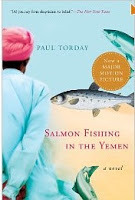 Although characters are changed from book to film, and the book itself is written though a series of emails, diaries, and correspondence, the message remains the same: suspend your disbelief and go for the dream. It’s not just about creating a salmon fishing oasis in a desert: political machinations, love, marriage, relationships, trust, faith and loyalty are all put to the test in a gentle, but unrelenting way. It’s also about the absurdities in life. A scheme that seems doomed from the start actually works because of the passion of the people involved. Things go wrong, disasters strike, but an underlying determination keeps the wheels turning.
Although characters are changed from book to film, and the book itself is written though a series of emails, diaries, and correspondence, the message remains the same: suspend your disbelief and go for the dream. It’s not just about creating a salmon fishing oasis in a desert: political machinations, love, marriage, relationships, trust, faith and loyalty are all put to the test in a gentle, but unrelenting way. It’s also about the absurdities in life. A scheme that seems doomed from the start actually works because of the passion of the people involved. Things go wrong, disasters strike, but an underlying determination keeps the wheels turning.The author is a British businessman and dedicated angler who has found a quite marvellous way of combining his passion with his opinions on life and politics.
It’s a gentle reminder of what life can be like, how dreams can be achieved, and the impossible made possible. I shall now get the book and enjoy the story all over again!
Published on February 03, 2013 00:23
January 30, 2013
When I Judge a Book by its Cover...
When I judge a book by its cover, it means I want to show off a fabulous new book with a beautiful cover, in my huge sets of bookcases that dominate my living room. I love real books. I won’t say I hate e-books, but I’ll only buy an e-reader when no more real books are printed. Given the number of people who also love real books, maybe we can stave off that awful day. I wonder if many people know this, but when you buy a real book and take it home to gloat over, it’s actually yours for keeps. When you buy an e-book, you’re actually only buying the right to read it… But, hey, let’s not go into all that. Let’s stick to real books.
This post was inspired by my annual attendance at the Exclusive Book’s annual sale. (Exclusive Books is South Africa’s leading bookstore and cleverly align themselves with a coffee shop to add extra comfort to book-lover browsing) People love the sale because all the books are marked down, and it’s one way of stocking up on expensive items that might just break the budget. So, what did I buy this year? Aha! I generally pick non-fiction because they are usually hard cover. I also tend to read a lot of non-fiction for research into my children’s adventure series, and because I like history. The Secret History of Giants by Ari Berk
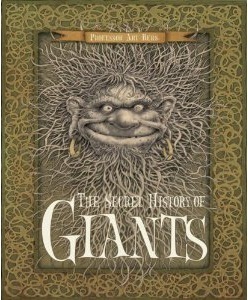 I know giants are not strictly non-fiction, but ever since a light-fingered somebody walked off with my Book of Giants (no longer in print), I have wanted a replacement. I mean, what is a home without a book on giants? I already have Brian Froud’s Faeries and The Book of Good and Bad Faeries, so definitely a giant replacement was on the cards. This is what the blurb says: Ancient Greece had its Titans, the Celts their Green Knight, the Bible Goliath—and for those who know where to look, signs of these legendary hulking creatures still abound. Now comes a hugely engrossing chronicle of giants since antiquity, from their role in forming mountains and causing earthquakes to the mysteries of their sacks (watch out for hitchhiking humans); from their means of employment (how did the Druids built Stonehenge?) to an extensive map of places around the world where giants may likely be found. Exhaustive and lushly illustrated, this enormously valuable resource is sure to fascinate all who open its covers.
I know giants are not strictly non-fiction, but ever since a light-fingered somebody walked off with my Book of Giants (no longer in print), I have wanted a replacement. I mean, what is a home without a book on giants? I already have Brian Froud’s Faeries and The Book of Good and Bad Faeries, so definitely a giant replacement was on the cards. This is what the blurb says: Ancient Greece had its Titans, the Celts their Green Knight, the Bible Goliath—and for those who know where to look, signs of these legendary hulking creatures still abound. Now comes a hugely engrossing chronicle of giants since antiquity, from their role in forming mountains and causing earthquakes to the mysteries of their sacks (watch out for hitchhiking humans); from their means of employment (how did the Druids built Stonehenge?) to an extensive map of places around the world where giants may likely be found. Exhaustive and lushly illustrated, this enormously valuable resource is sure to fascinate all who open its covers.Special features include: sundry flaps, booklets, and gatefolds; a lavish foiled and embossed cover (and it is lavish!); an elegant tassel (very elegant!) dangling from the spine.
Babylon: Mesopotamia and the Birth of Civilization by Paul Kriwaczek
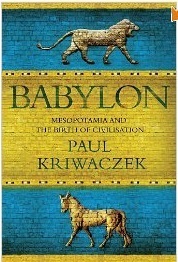 Civilization was born eight thousand years ago, between the floodplains of the Tigris and Euphrates rivers, when migrants from the surrounding mountains and deserts began to create increasingly sophisticated urban societies. In the cities that they built, half of human history took place. In Babylon, Paul Kriwaczek tells the story of Mesopotamia from the earliest settlements seven thousand years ago to the eclipse of Babylon in the sixth century BCE. Bringing the people of this land to life in vibrant detail, the author chronicles the rise and fall of power during this period and explores the political and social systems, as well as the technical and cultural innovations, which made this land extraordinary. At the heart of this book is the story of Babylon, which rose to prominence under the Amorite king Hammurabi from about 1800 BCE. Even as Babylon’s fortunes waxed and waned, it never lost its allure as the ancient world’s greatest city. Engaging and compelling, Babylon reveals the splendor of the ancient world that laid the foundation for civilization itself. (I can’t wait to get stuck into this!) House of Wisdom by Jonathan Lyons
Civilization was born eight thousand years ago, between the floodplains of the Tigris and Euphrates rivers, when migrants from the surrounding mountains and deserts began to create increasingly sophisticated urban societies. In the cities that they built, half of human history took place. In Babylon, Paul Kriwaczek tells the story of Mesopotamia from the earliest settlements seven thousand years ago to the eclipse of Babylon in the sixth century BCE. Bringing the people of this land to life in vibrant detail, the author chronicles the rise and fall of power during this period and explores the political and social systems, as well as the technical and cultural innovations, which made this land extraordinary. At the heart of this book is the story of Babylon, which rose to prominence under the Amorite king Hammurabi from about 1800 BCE. Even as Babylon’s fortunes waxed and waned, it never lost its allure as the ancient world’s greatest city. Engaging and compelling, Babylon reveals the splendor of the ancient world that laid the foundation for civilization itself. (I can’t wait to get stuck into this!) House of Wisdom by Jonathan Lyons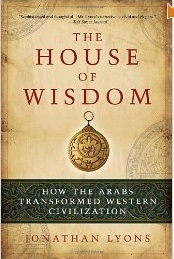
Although I see this book received mixed reviews on Amazon, I’m willing to give it a chance. The blurb says: For centuries following the fall of Rome, Western Europe was a benighted backwater, a world of subsistence farming, minimal literacy, and violent conflict. Meanwhile Arab culture was thriving, dazzling those Europeans fortunate enough to visit cities like Baghdad or Antioch. There, philosophers, mathematicians, and astronomers were steadily advancing the frontiers of knowledge, as well as keeping alive the works of Plato and Aristotle. When the best libraries in Europe held several dozen books, Baghdad's great library, The House of Wisdom, housed four hundred thousand. Jonathan Lyons shows just how much "Western" ideas owe to the Golden Age of Arab civilization. Even while their countrymen waged bloody Crusades against Muslims, a handful of intrepid Christian scholars, hungry for knowledge, traveled East and returned with priceless jewels of science, medicine, and philosophy that laid the foundation for the Renaissance. In this brilliant, evocative book, Jonathan Lyons reveals the story of how Europe drank from the well of Muslim learning. The Illustrated Anthology of World Myth andStory Telling by C. Scott Littleton (editor)
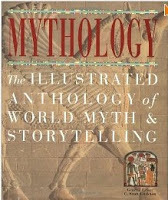
I was lucky enough to receive this wonderful anthology as a Christmas present. I have already dipped into it and it’s just wonderful. The blurb says: Myths are the timeless expression of the imagination born out of the need to make sense of the universe. Moving across the centuries, they resonate with our deepest feelings about the fragility and grandeur of existence. Mythology is a comprehensive, richly illustrated survey of the mythic imagination in all its forms around the world, from the odysseys, quests, and battles of ancient Greece and Rome to the living beliefs of indigenous cultures in the Americas, Africa, and Oceania. Looking at each major myth-making culture in turn, this book retells some of the most significant and captivating stories in a lively, contemporary style. Generously illustrated with more than 700 color photographs, Mythology brings you the vibrant stories that echo time and again in our lives.
Back to the covers: a gleeful giant peeking out of one cover, a Babylonian lion striding across a turquoise background, the delicate beauty of Arabian craftsmanship, and a winged Assyrian sculpture on a sandstone background, these books all merit pride of place in the looks department, and I am sure contain a wealth of knowledge!
by Fiona Ingram
Published on January 30, 2013 01:30
January 24, 2013
Daniel Deronda: Book to BBC Classic
I recently watched the wonderful BBC adaptationof George Eliot’s novel Daniel Deronda , starring Hugh Dancy as the eponymous hero, the ethereally beautiful Romola Garai as Gwendolen Harleth, Hugh Bonneville as the smug Henleigh Mallinger Grandcourt, and a host of other BBC stalwarts that added visual depth and emotional intensity to this film.
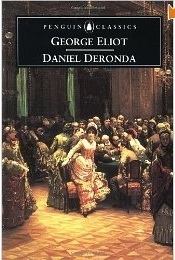 Daniel Deronda was first published in 1876. It was the last novel Eliot completed and the only one set in the contemporary Victorian society of her day. Its mixture of social satire and moral searching, along with a sympathetic rendering of Jewish proto-Zionist and Kabbalistic ideas has made it a controversial final statement of one of the greatest of Victorian novelists. An article in the Guardian discusses how Eliot actually shocked some of her readers by dealing with this topic and emphasises how Eliot’s portrayal of Judaism and Zionism continues to resonate. For me, Eliot highlights the themes of inner and outer struggles in the characters’ search for meaning, identity, and self-worth.
Daniel Deronda was first published in 1876. It was the last novel Eliot completed and the only one set in the contemporary Victorian society of her day. Its mixture of social satire and moral searching, along with a sympathetic rendering of Jewish proto-Zionist and Kabbalistic ideas has made it a controversial final statement of one of the greatest of Victorian novelists. An article in the Guardian discusses how Eliot actually shocked some of her readers by dealing with this topic and emphasises how Eliot’s portrayal of Judaism and Zionism continues to resonate. For me, Eliot highlights the themes of inner and outer struggles in the characters’ search for meaning, identity, and self-worth.This is a deep novel and hard to outline in a blog post. However, information on Wikipedia (see below) has proved incredibly useful in understanding the greater themes of this riveting book.
Daniel Deronda is the ward of the wealthy Sir Hugo Mallinger and hero of the novel, Deronda has a tendency to help others at a cost to himself. At the start of the novel, he has failed to win a scholarship at Cambridge because of his focus on helping a friend, has been travelling abroad, and has just started studying law. He often wonders about his birth, and whether or not he is a gentleman. As he moves more and more among the world-within-a-world of the Jews of the novel, he begins to identify with their cause in direct proportion to the unfolding revelations of his ancestry. Eliot used the story of Moses as part of her inspiration for Deronda. As Moses was a Jew brought up as an Egyptian who ultimately led his people to the Promised Land, so Deronda is a Jew brought up as an Englishman, and the novel ends with his plan to do the same.
Gwendolen Harleth is the beautiful, spoiled daughter of a widowed mother. Much courted by men, she is flirtatious but ultimately self-involved. Early in the novel, her family suffers a financial crisis, and she is faced with becoming a governess to help support herself and her family. Seeking an escape, she explores the idea of becoming an actress and singer but ultimately marries the controlling and cruel Henleigh Grandcourt, although she does not love him. Desperately unhappy, she seeks help from Deronda, who offers her understanding, moral support, and the possibility of a way out of her guilt and sorrow. As a psychological study of an immature egoist struggling to achieve greater understanding of herself and others through suffering, Gwendolen is, for many, Eliot's crowning achievement as a novelist and the real core of the book.
 Daniel Deronda is composed of two interwoven stories and presents two worlds that are never completely reconciled. Indeed, the separation of the two and the eventual parting of one from the other is one of the novel's major themes. There is the fashionable, familiar, upper-class English world of Gwendolen Harleth and the less familiar society-within-a-society inhabited by the Jews, most importantly Mordecai (or Ezra) Cohen and his sister, Mirah. Living between these two worlds is Daniel, who gradually identifies more and more with the Jewish side as he comes to understand the mystery of his birth and develops his relationships with Mordecai and Mirah. In the novel, the Jewish characters' spirituality, moral coherence, and sense of community are contrasted favourably with the materialist, philistine, and largely corrupt society of England. The inference seems to be that the Jews' moral values are lacking in the wider British society that surrounds them.
Daniel Deronda is composed of two interwoven stories and presents two worlds that are never completely reconciled. Indeed, the separation of the two and the eventual parting of one from the other is one of the novel's major themes. There is the fashionable, familiar, upper-class English world of Gwendolen Harleth and the less familiar society-within-a-society inhabited by the Jews, most importantly Mordecai (or Ezra) Cohen and his sister, Mirah. Living between these two worlds is Daniel, who gradually identifies more and more with the Jewish side as he comes to understand the mystery of his birth and develops his relationships with Mordecai and Mirah. In the novel, the Jewish characters' spirituality, moral coherence, and sense of community are contrasted favourably with the materialist, philistine, and largely corrupt society of England. The inference seems to be that the Jews' moral values are lacking in the wider British society that surrounds them.The BBC never fails in its visually compelling and captivating adaptations of classic novels. The series is beautifully photographed, with the wealth and opulence of the British upper class severely contrasted with the squalor and poverty of the poorer levels of society. The acting is wonderful, and Dancy and Garai are just perfect as the main characters. Familiar faces from previous BBC classics are evident, and overall, present a sterling cast.
There is so much more to this book than what I have outlined, but if the idea of 484 pages is too daunting, see the series first to get acquainted with the novel.
by Fiona Ingram
Published on January 24, 2013 02:51
January 8, 2013
Best Book Awards for Indie Authors
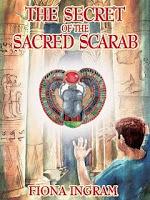 As the New Year begins, so you should start gearing up for book awards. Entering book awards is not as difficult as it seems. In a previous post I outlined the pros and cons of entering, and having achieved eleven awards and nominations, I find there are definite benefits. Your book’s recognition enhances its status, no doubt about it, and tells people you have reached a standard of excellence that meets the industry’s demands. I recently read four posts by industry marketing experts with their take on why you should enter book awards.
As the New Year begins, so you should start gearing up for book awards. Entering book awards is not as difficult as it seems. In a previous post I outlined the pros and cons of entering, and having achieved eleven awards and nominations, I find there are definite benefits. Your book’s recognition enhances its status, no doubt about it, and tells people you have reached a standard of excellence that meets the industry’s demands. I recently read four posts by industry marketing experts with their take on why you should enter book awards.Advice from the Experts Donna M. McDine on children’s book awards: The importance of entering children’s book award contests goes well beyond a win. There are two sides you can capitalize on. The obvious, if your book achieves book award recognition you and your publisher can reap the benefits of promoting you as an award-winning author. Second, even if you don’t place in the contest your book does gain additional exposure through the judging process.Donna includes a list of helpful places to find the best contests.
 Dana Lynn Smith on choosing wisely:
Begin by considering which contests are most appropriate for your book. Some are very general, while others focus on a specific type of book. Some book award contests accept entries with the current or previous year’s copyright date, while others allow entries spanning several years. Some are geared toward self-published books and others accept all books. When deciding which contests are the best fit, look for those that offer book categories most related to the type of book that you write. For example, “historical romance” is much more specific than “romance.” Also consider the entry fees and the relative prestige and publicity value of the contest. Some contests even offer cash prizes for the top winners.Dana also includes a list of popular/best known contests. Her advice on e-book vs. print is: If a contest accepts both e-books and printed books, it’s usually best to submit a printed book if you have one because it’s more tangible.
Dana Lynn Smith on choosing wisely:
Begin by considering which contests are most appropriate for your book. Some are very general, while others focus on a specific type of book. Some book award contests accept entries with the current or previous year’s copyright date, while others allow entries spanning several years. Some are geared toward self-published books and others accept all books. When deciding which contests are the best fit, look for those that offer book categories most related to the type of book that you write. For example, “historical romance” is much more specific than “romance.” Also consider the entry fees and the relative prestige and publicity value of the contest. Some contests even offer cash prizes for the top winners.Dana also includes a list of popular/best known contests. Her advice on e-book vs. print is: If a contest accepts both e-books and printed books, it’s usually best to submit a printed book if you have one because it’s more tangible.Sherrie Wikolaski has advice on getting the best out of your entry fee: Investment. Book awards can range from as little as $10 per submission to a few hundred dollars. Most fall somewhere in the middle, plus the cost of mailing in a copy of the book for review. It’s one of the most cost-effective ways to market your book, especially if you win.
 Marketing your winnings. Congratulations! You’ve won! Now what? When the time comes and you’ve found out that your book has won an award, you should maximize the win. Find out what the awards committee is doing to promote your award status. Take advantage of everything they are offering to you. If they invite you to guest blog, take it. If they want to promote a book excerpt, let them. Whatever they offer be sure to work with their marketing team to maximize your exposure.Sherrie includes a list of top book contests as well as marketing tips to maximise on your win.
Marketing your winnings. Congratulations! You’ve won! Now what? When the time comes and you’ve found out that your book has won an award, you should maximize the win. Find out what the awards committee is doing to promote your award status. Take advantage of everything they are offering to you. If they invite you to guest blog, take it. If they want to promote a book excerpt, let them. Whatever they offer be sure to work with their marketing team to maximize your exposure.Sherrie includes a list of top book contests as well as marketing tips to maximise on your win.Smith Publicity, book promoters for authors in every genre worldwide, includes a long list of book awards ranging from general fiction to science fiction, mystery, indie, self-help, non-fiction, cultural and youth.
The Indie Issue Many indie authors are put off by thinking that so many contests only accept traditionally published books. Not true. I am a self-published author and by keeping an eye on industry events, I was able to enter and achieve something in most of the contests. I have compiled a list of indie awards, by date, to make it easier for authors to enter their books. Expense is also a big issue with authors battling to pay for editing, layout, cover images etc. The beauty of the e-book revolution is that many contests organisers now accept e-books. This makes entering a whole lot easier. Please visit the links from the experts above. They have many tips to offer ranging from why enter, to how to organise your entries, to the benefits, to author beware.
Here is a calendar of the most useful contests for indie authors
January: Childrens’ Literary Classics Awards (e-book accepted if print copy not available)
Foreword Book of the Year Awards (print and e-book)
Eric Hoffer Awards(e-book accepted)
e-Lit Awards(e-book)
Beverly Hills Book Awards (print only)
February: Next Generation Indie Book Awards (e-book accepted)
Wise Bear Book Awards (e-book accepted)
March: Independent Publisher Book Awards (IPPY) (print and e-book)
Indie Reader Discovery Awards (both print and e-book)
April: National Indie Excellence Book Awards (print only)
Moonbeam Children’s Book Awards (print only)
Global E-book Awards(e-books)
May:Readers Favorite Awards (e-book accepted)
June: Readers Digest Self-Published Awards (print only)
September: Rubery Book Awards(e-book accepted)
National Best Book Awards (e-book accepted)
Sharpwrit Book Awards (e-book accepted)
Nautilus Book Awards (print only)
December: Reader Views Literary Awards (e-book accepted if print copy not available)
Start planning and remember you can't win if you don't enter!
Published on January 08, 2013 07:03
January 3, 2013
The Hobbit: An Unexpected Adventure
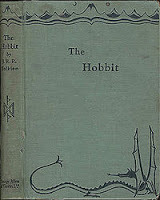 The Hobbit first edition
The Hobbit
is the first step on Tolkien’s long journey into Middle-earth. The story is set in Middle-earth sixty years before The Lord of the Rings, and portions of the film are adapted from the appendices to Tolkien's The Return of the King novel. An Unexpected Journey tells of the hobbit Bilbo Baggins (Martin Freeman), who is convinced by the wizard Gandalf (Ian McKellen) to accompany thirteen dwarves led by Thorin Oakenshield (Richard Armitage) on a quest across Middle-earth to reclaim the Lonely Mountain from Smaug the dragon.
The Hobbit first edition
The Hobbit
is the first step on Tolkien’s long journey into Middle-earth. The story is set in Middle-earth sixty years before The Lord of the Rings, and portions of the film are adapted from the appendices to Tolkien's The Return of the King novel. An Unexpected Journey tells of the hobbit Bilbo Baggins (Martin Freeman), who is convinced by the wizard Gandalf (Ian McKellen) to accompany thirteen dwarves led by Thorin Oakenshield (Richard Armitage) on a quest across Middle-earth to reclaim the Lonely Mountain from Smaug the dragon.
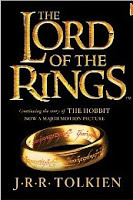 Lord of the RingsI saw the movie twice, within a short space of time (all right, four days!), and just loved it all over again. Amazingly, the book has never been out of print, and encouraged by the book's critical and financial success, the publisher requested a sequel.
The Lord of the Rings
was the result. So much has been written on that subject I won’t even try to offer an opinion, suffice to say that I am a huge fan of the book, and regularly reread the tome.
Lord of the RingsI saw the movie twice, within a short space of time (all right, four days!), and just loved it all over again. Amazingly, the book has never been out of print, and encouraged by the book's critical and financial success, the publisher requested a sequel.
The Lord of the Rings
was the result. So much has been written on that subject I won’t even try to offer an opinion, suffice to say that I am a huge fan of the book, and regularly reread the tome.I read a few reviews of The Hobbit movie before I saw it and although there were some complaints, I was undeterred. I went determined to enjoy myself. I did not notice the 48 versus 24 whatever per second that people said made it blurry or ‘unreal.’ I did not notice the length—I could have sat through another three hours quite happily. And as for one critic saying all the dwarves were the same, well, they were not at all. With the second viewing, I noticed small but pertinent details that gave every character his unique aspect. I absolutely loved the grand, nay, spectacular setting, and being a huge fan of the LOTRtrilogy, it was wonderful to see the fantastic scenery again unfold on the big screen.
Some critics complained that the quest was drawn out and could hardly fill the time allotted to it. However, The Hobbit’s quest is smaller, more intimate, and the fate of Middle-earth is not the issue. The fate of the dwarves’ home is the central theme, as well as Bilbo’s personal growth into a brave hobbit. Here, as well, is where the One Ring makes its first appearance. Everyone’s individual quest is naturally scaled down, but no less important than the grand quest of LOTR.
However, the best part of my trip to the movies was this: a visit to a bookstore in the cinema complex displaying a host of books dealing with The Hobbit and LOTR. Books. Real books. Books in print. Books with richly embossed covers and fabulous illustrations. Not e-books. That, for me, was the best part. How can anyone expect to appreciate the grandeur of Tolkien’s vision on a Kindle or e-reader? So, when all is said and done, just remember that real books are an unexpected adventure in themselves.I have just read an article on the dire situation facing Britain’s High Street bookshops (they have halved!) in which the writer (Allan Massie) says that bookshops have to get more personal to survive. Call us old-fashioned but bookshops seem to still be alive and well in South Africa. They are bright, welcoming, colourful, with displays of the latest books, and (cleverly) are usually aligned to a coffee shop. You can browse as much as you like, enjoy your coffee, read the latest newspapers and books, and no one chases you out for lounging among the best examples of the written word. Long live bookshops, I say!
Here are just some of the wonderful visual accompaniments to the film.
 Don't forget the map!
Don't forget the map!
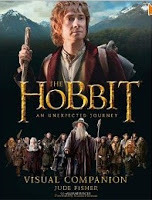 Richly illustrated with more than 100 colour photos from the film, and featuring a brand new fold-out map charting the journey from Bag End to Wilderland, TheHobbit: An Unexpected Journey Visual Companion begins the Quest for the Lonely Mountain in spectacular style.
Richly illustrated with more than 100 colour photos from the film, and featuring a brand new fold-out map charting the journey from Bag End to Wilderland, TheHobbit: An Unexpected Journey Visual Companion begins the Quest for the Lonely Mountain in spectacular style.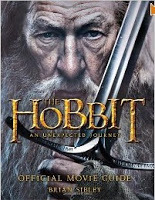 Enter Bilbo Baggins’ world through exclusive interviews with director Peter Jackson, Martin Freeman, Ian McKellen and all the principal cast and filmmakers, who share film-making secrets and tales of what it was actually like making movie magic in Middle-earth.
Enter Bilbo Baggins’ world through exclusive interviews with director Peter Jackson, Martin Freeman, Ian McKellen and all the principal cast and filmmakers, who share film-making secrets and tales of what it was actually like making movie magic in Middle-earth.Lavishly illustrated with hundreds of behind-the-scenes photos of the actors, locations, sets, creatures and costumes, TheHobbit: An Unexpected Journey Official Movie Guide has been produced in collaboration with the filmmakers who have brought J.R.R. Tolkien’s classic novel into breath-taking three-dimensional life.
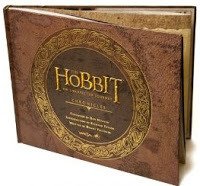 The Hobbit: An Unexpected Journey Chronicles: Art & Design is a sumptuous celebration of the creative vision of Academy Award-winning filmmaker Peter Jackson's The Hobbit: An Unexpected Journey. The book is packed with more than 1,000 images of concept artwork, photographs, and development paintings by the artists working behind the scenes to bring Middle-earth to life, who each provide detailed and entertaining commentary that reveals the story behind the vision. As a bonus feature unique to this book, there is a special fold-out map printed in glow-in-the-dark ink and a giant four-page fold-out of Bilbo's contract.
The Hobbit: An Unexpected Journey Chronicles: Art & Design is a sumptuous celebration of the creative vision of Academy Award-winning filmmaker Peter Jackson's The Hobbit: An Unexpected Journey. The book is packed with more than 1,000 images of concept artwork, photographs, and development paintings by the artists working behind the scenes to bring Middle-earth to life, who each provide detailed and entertaining commentary that reveals the story behind the vision. As a bonus feature unique to this book, there is a special fold-out map printed in glow-in-the-dark ink and a giant four-page fold-out of Bilbo's contract.
 Of course, the contract!
Of course, the contract!  In
The Lord of the Rings Sketchbook
, Alan Lee, the Oscar-winning conceptual designer for the Lord of the Rings movie trilogy, discusses his approach to depicting Tolkien’s imaginary world. The book presents more than 150 of Lee’s celebrated illustrations to show how his imagery for both the illustrated Lord of the Rings and the films progressed from concept to finished art. In addition, the book contains 20 full-colour plates and numerous examples of the conceptual art produced for Peter Jackson’s film adaptation.
In
The Lord of the Rings Sketchbook
, Alan Lee, the Oscar-winning conceptual designer for the Lord of the Rings movie trilogy, discusses his approach to depicting Tolkien’s imaginary world. The book presents more than 150 of Lee’s celebrated illustrations to show how his imagery for both the illustrated Lord of the Rings and the films progressed from concept to finished art. In addition, the book contains 20 full-colour plates and numerous examples of the conceptual art produced for Peter Jackson’s film adaptation.Happy reading, and if you haven’t seen The Hobbit yet, go and enjoy director Peter Jackson’s splendid vision.
By Fiona Ingram
Published on January 03, 2013 02:58
December 6, 2012
NaNoWriMo and Me Redux
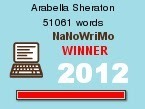 Well, 30 November has been and gone and I completed NaNoWriMo. Yes—applause, applause— I did it. I finished off with a very healthy 51000+ word count, and I will be submitting the book—The Lady’s Revenge— to my romance publishers (gulp, yes I write historical romance for fun) MusaPublishing. This is the sixth novel I have written in the romance genre and it is a whole lot of fun. My romance pseudonym is Arabella Sheraton. You can find my Regency romance books on Amazon.
Well, 30 November has been and gone and I completed NaNoWriMo. Yes—applause, applause— I did it. I finished off with a very healthy 51000+ word count, and I will be submitting the book—The Lady’s Revenge— to my romance publishers (gulp, yes I write historical romance for fun) MusaPublishing. This is the sixth novel I have written in the romance genre and it is a whole lot of fun. My romance pseudonym is Arabella Sheraton. You can find my Regency romance books on Amazon.So, what did I learn from NaNoWriMo?I learned how to write a lot in a short space of time and under constant pressure. The problem with authors is that there’s always time to fiddle about, tweaking a paragraph, rewriting a section, and changing words here and there. Often a whole day passes, with no real word count achieved. The pressure of NaNoWriMo soon clears that up!My own style is linear, with deviations into the subplots. I often have whole scenes or else the ending written in my head, and I occasionally write a scene that is much later in my work. However, I usually progress at a steady pace, tying up the plot links as I go along. NaNoWriMo forces you to see the whole story in a big global picture. Well, if you want to keep track of where you’re going, that’s what I mean. I like to develop chapters by going back after a day or two, and fleshing them out. Not a chance here. With a word count pressing,one has to leave the cosmetic stuff until much later.
One might think that just over 1600 words a day is not difficult to achieve. No, it’s not, but how about the days when you just cannot write because pesky old life and responsibilities get in the way? I found a sense of drive developing in me, like an obsession. I had to get over the daily word count; I just had to!
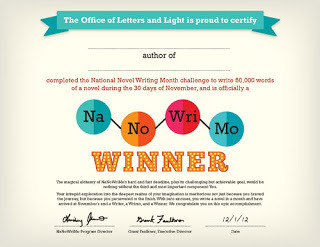 Then there is the ‘don’t edit’ rule. Impossible. I must edit as I go along. I would sneak back, under cover of darkness and edit what I had done that day. I could not bear the red and green lines, bleeping signals that my grammar and spelling looked horrendous in the flurry of flying fingers. Actually, my spelling is perfect; it’s my typing that isn’t.
Then there is the ‘don’t edit’ rule. Impossible. I must edit as I go along. I would sneak back, under cover of darkness and edit what I had done that day. I could not bear the red and green lines, bleeping signals that my grammar and spelling looked horrendous in the flurry of flying fingers. Actually, my spelling is perfect; it’s my typing that isn’t.I am a disciplined writer. Being a writer is like having permanent homework; you feel guilty if you are not pounding away at the keyboard. However, this was a different kind of discipline, or even pressure. There was a definite end date in sight. Many writers let the work dictate the finish time. Not so with NaNoWriMo.
I am reminded of lines from Andrew Marvell (metaphysical poet 1621-1678) in a poem entitled To His Coy Mistress:
“ ...But at my back I always hear
Time's winged chariot hurrying near…”
Kristen Lamb talks about discipline in her blog post entitled NaNoNowWHAT? Small Steps for BIG Change. She discusses how you don’t always get what you wish for: you get what you work for.
Becoming an Olympic champion requires more than just athletic prowess; it also depends on the ability to focus, mental toughness, drive, optimism and emotional control. We could just as easily reword this statement:
Becoming a successful author requires more than just creative talent; it also depends on the ability to focus, mental toughness, drive, optimism, and emotional control.
I loved the NaNoWriMo experience and the sense of being part of a writing community is great. The total number of winning participants was 170294 worldwide; the combined word count was a staggering 321 949 2657. That’s something to be proud of!
By Fiona Ingram
Published on December 06, 2012 06:11
November 25, 2012
Reading with the Children of Fire
Meeting some of the Children of Fire was a most surprising experience. With my beloved mom passing away recently, and my adopted daughter graduated from high school and in college, I now have a few extra hours on my hands each week. You might think, “Oh, write, write more!” But there’s a limit to what one can squeeze out of an already-squeezed brain when it comes to creativity.

The American tradition of Thanksgiving also made me start thinking about what I have and giving thanks for it. After all, I have so much to be grateful for. My wonderful mother left me comfortably established, and her help enabled me to give up the rat race and just stay at home and write all day. There are so many needy organisations, run by wonderful selfless people, that I didn’t have to think very hard about where to devote some of this extra time.
I met Bronwen Jones (the founder of Children of Fire) briefly about ten years ago, with her badly burned daughter, Dorah. At the time, I was struck by Dorah’s happiness and self-assurance, despite her terrible burns. Bronwen gave me her card, which I kept, and the encounter stayed in the back of my mind somewhere.
What is Children of Fire?
Children of Fire is a charity based in the UK and in South Africa, which assists badly burned children with reconstructive surgery and other necessities. The organization also promotes legislation and legal assistance for children who are disabled through burn injuries.
In 1997, the organization began as a charitable trust to assist Dorah Mokoena, a badly burned South African child who was turned away from several hospitals. After The Times of London published an appeal, the Dorah Mokoena Charitable Trust was formed in London to accept donations, and the Children of Fire in South Africa to handle Dorah and other children's rehabilitation. This evolved into one name Children of Fire active mostly in Southern Africa, but with legal entities existing or in progress in the USA, North Africa, Central Africa, South Africa, and the UK, which all assist other children injured by fire. Since first helping Dorah 17 years ago, ChiFi has helped 350 children with severe burns as well as others from across Africa who required less complicated surgery.
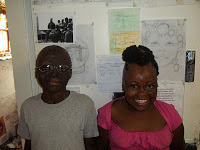 Children of Fire keep smiling!I went along on Saturday afternoon to offer my services in the reading/writing/acting/having fun with books department, and to meet some of the kids. It was great. A mixture of ages, and varying degrees of disabilities, but a wonderful sense of fun and excitement. They all have remarkable self-confidence, laugh, talk, and jostle for attention, and I can only put this down to Bronwen’s love, compassion, and ability to make each child feel special. They had just been to a function that involved lots of popcorn, party hats, and a piñata that gave out sweets, so all the kids were in high spirits.
Children of Fire keep smiling!I went along on Saturday afternoon to offer my services in the reading/writing/acting/having fun with books department, and to meet some of the kids. It was great. A mixture of ages, and varying degrees of disabilities, but a wonderful sense of fun and excitement. They all have remarkable self-confidence, laugh, talk, and jostle for attention, and I can only put this down to Bronwen’s love, compassion, and ability to make each child feel special. They had just been to a function that involved lots of popcorn, party hats, and a piñata that gave out sweets, so all the kids were in high spirits.
I took my book, The Secret of the Sacred Scarab, as well as a large full-colour (fabulous) book on Egypt, some posters, bookmarks, and we went for a brief little holiday to Egypt. Reading aloud to kids who want to listen, and experience some of the wonder of imagination and fantasy is very rewarding and fulfilling. Because of their injuries, some kids do not get enough schooling—much time is spent in hospital, with ongoing procedures interrupting the learning process. ChiFi has a sister charity the Johannesburg School for Blind, Low Vision and Multiple Disability Children (known as Beka), a school with a staff of three teachers to ensure the children have access to education while undergoing treatment. Other kids have coped wonderfully and are about to embark on high school, some are in university, and some are employed.
 Seiso's torture burns are hidden by clothesBurn injuries are a terrible and harrowing experience for children. More than 90 percent of burn injuries occur in developing countries and 70 percent of these are in children, according to statistics compiled by the Welsh Centre for Burns and Plastic Surgery in the United Kingdom and the Dow University Medical College Burns Centre, Pakistan. Accurate paediatric burn statistics in Africa are hard to find.
Seiso's torture burns are hidden by clothesBurn injuries are a terrible and harrowing experience for children. More than 90 percent of burn injuries occur in developing countries and 70 percent of these are in children, according to statistics compiled by the Welsh Centre for Burns and Plastic Surgery in the United Kingdom and the Dow University Medical College Burns Centre, Pakistan. Accurate paediatric burn statistics in Africa are hard to find.
At least 15,000 children in South Africa are burnt every year, according to ChiFi estimates. The figures are higher in winter when the chances of children rolling half asleep into open fires lit to warm their rooms are higher. Sadly, one in three severe child burns are intentional in South Africa.
In the five biggest cities in South Africa an average of 200 people die in shack fires every year, according to Abahlali baseMjondolo, a South African shack dwellers' movement.
 Little Perlucia rebuilding lifeApart from the actual burn injuries, many children come to the charity with extra problems such as starvation, malnutrition, HIV/Aids, as well as poverty-related illnesses. Added to the trauma of the burn experience is fear of the reconstructive and healing process with children being terrified at the sight of medical doctors in white coats, the fear of pain, and ultimately having to learn to live again.
Little Perlucia rebuilding lifeApart from the actual burn injuries, many children come to the charity with extra problems such as starvation, malnutrition, HIV/Aids, as well as poverty-related illnesses. Added to the trauma of the burn experience is fear of the reconstructive and healing process with children being terrified at the sight of medical doctors in white coats, the fear of pain, and ultimately having to learn to live again.
Funding
ChiFi works with a network of doctors, surgeons and health care specialists, many of whom volunteer their services. The charity has never received any government aid and operates entirely on public donations, using volunteers from across the world. Reconstructive surgery is incredibly expensive, and funding is always welcome.
Education
 Education is the number one priority. Besides helping children with burn injuries, ChiFi also tries to educate communities on how to prevent fires. The charity also helps communities affected by fires rebuild their lives with construction materials and other household essentials. However, the biggest challenge is educating people to see these Children of Fire not as victims but as tough survivors. These children have ongoing lives to lead, goals to achieve, and the ability to give and receive love.
Education is the number one priority. Besides helping children with burn injuries, ChiFi also tries to educate communities on how to prevent fires. The charity also helps communities affected by fires rebuild their lives with construction materials and other household essentials. However, the biggest challenge is educating people to see these Children of Fire not as victims but as tough survivors. These children have ongoing lives to lead, goals to achieve, and the ability to give and receive love.
How You Can Help!
Visit the website and see how you can help. Your few dollars and pounds translate into a nice big amount, given the exchange rate for foreign currency. If you live in South Africa, visit the site and ask to be emailed the latest wish list. They need so much that we take for granted. Charity begins at home, and if we all help, in whatever small way we can, ChiFi can expand its operations to take in many more needy children and set them back on their life path.


The American tradition of Thanksgiving also made me start thinking about what I have and giving thanks for it. After all, I have so much to be grateful for. My wonderful mother left me comfortably established, and her help enabled me to give up the rat race and just stay at home and write all day. There are so many needy organisations, run by wonderful selfless people, that I didn’t have to think very hard about where to devote some of this extra time.
I met Bronwen Jones (the founder of Children of Fire) briefly about ten years ago, with her badly burned daughter, Dorah. At the time, I was struck by Dorah’s happiness and self-assurance, despite her terrible burns. Bronwen gave me her card, which I kept, and the encounter stayed in the back of my mind somewhere.
What is Children of Fire?
Children of Fire is a charity based in the UK and in South Africa, which assists badly burned children with reconstructive surgery and other necessities. The organization also promotes legislation and legal assistance for children who are disabled through burn injuries.
In 1997, the organization began as a charitable trust to assist Dorah Mokoena, a badly burned South African child who was turned away from several hospitals. After The Times of London published an appeal, the Dorah Mokoena Charitable Trust was formed in London to accept donations, and the Children of Fire in South Africa to handle Dorah and other children's rehabilitation. This evolved into one name Children of Fire active mostly in Southern Africa, but with legal entities existing or in progress in the USA, North Africa, Central Africa, South Africa, and the UK, which all assist other children injured by fire. Since first helping Dorah 17 years ago, ChiFi has helped 350 children with severe burns as well as others from across Africa who required less complicated surgery.
 Children of Fire keep smiling!I went along on Saturday afternoon to offer my services in the reading/writing/acting/having fun with books department, and to meet some of the kids. It was great. A mixture of ages, and varying degrees of disabilities, but a wonderful sense of fun and excitement. They all have remarkable self-confidence, laugh, talk, and jostle for attention, and I can only put this down to Bronwen’s love, compassion, and ability to make each child feel special. They had just been to a function that involved lots of popcorn, party hats, and a piñata that gave out sweets, so all the kids were in high spirits.
Children of Fire keep smiling!I went along on Saturday afternoon to offer my services in the reading/writing/acting/having fun with books department, and to meet some of the kids. It was great. A mixture of ages, and varying degrees of disabilities, but a wonderful sense of fun and excitement. They all have remarkable self-confidence, laugh, talk, and jostle for attention, and I can only put this down to Bronwen’s love, compassion, and ability to make each child feel special. They had just been to a function that involved lots of popcorn, party hats, and a piñata that gave out sweets, so all the kids were in high spirits. I took my book, The Secret of the Sacred Scarab, as well as a large full-colour (fabulous) book on Egypt, some posters, bookmarks, and we went for a brief little holiday to Egypt. Reading aloud to kids who want to listen, and experience some of the wonder of imagination and fantasy is very rewarding and fulfilling. Because of their injuries, some kids do not get enough schooling—much time is spent in hospital, with ongoing procedures interrupting the learning process. ChiFi has a sister charity the Johannesburg School for Blind, Low Vision and Multiple Disability Children (known as Beka), a school with a staff of three teachers to ensure the children have access to education while undergoing treatment. Other kids have coped wonderfully and are about to embark on high school, some are in university, and some are employed.
 Seiso's torture burns are hidden by clothesBurn injuries are a terrible and harrowing experience for children. More than 90 percent of burn injuries occur in developing countries and 70 percent of these are in children, according to statistics compiled by the Welsh Centre for Burns and Plastic Surgery in the United Kingdom and the Dow University Medical College Burns Centre, Pakistan. Accurate paediatric burn statistics in Africa are hard to find.
Seiso's torture burns are hidden by clothesBurn injuries are a terrible and harrowing experience for children. More than 90 percent of burn injuries occur in developing countries and 70 percent of these are in children, according to statistics compiled by the Welsh Centre for Burns and Plastic Surgery in the United Kingdom and the Dow University Medical College Burns Centre, Pakistan. Accurate paediatric burn statistics in Africa are hard to find. At least 15,000 children in South Africa are burnt every year, according to ChiFi estimates. The figures are higher in winter when the chances of children rolling half asleep into open fires lit to warm their rooms are higher. Sadly, one in three severe child burns are intentional in South Africa.
In the five biggest cities in South Africa an average of 200 people die in shack fires every year, according to Abahlali baseMjondolo, a South African shack dwellers' movement.
 Little Perlucia rebuilding lifeApart from the actual burn injuries, many children come to the charity with extra problems such as starvation, malnutrition, HIV/Aids, as well as poverty-related illnesses. Added to the trauma of the burn experience is fear of the reconstructive and healing process with children being terrified at the sight of medical doctors in white coats, the fear of pain, and ultimately having to learn to live again.
Little Perlucia rebuilding lifeApart from the actual burn injuries, many children come to the charity with extra problems such as starvation, malnutrition, HIV/Aids, as well as poverty-related illnesses. Added to the trauma of the burn experience is fear of the reconstructive and healing process with children being terrified at the sight of medical doctors in white coats, the fear of pain, and ultimately having to learn to live again. Funding
ChiFi works with a network of doctors, surgeons and health care specialists, many of whom volunteer their services. The charity has never received any government aid and operates entirely on public donations, using volunteers from across the world. Reconstructive surgery is incredibly expensive, and funding is always welcome.
Education
 Education is the number one priority. Besides helping children with burn injuries, ChiFi also tries to educate communities on how to prevent fires. The charity also helps communities affected by fires rebuild their lives with construction materials and other household essentials. However, the biggest challenge is educating people to see these Children of Fire not as victims but as tough survivors. These children have ongoing lives to lead, goals to achieve, and the ability to give and receive love.
Education is the number one priority. Besides helping children with burn injuries, ChiFi also tries to educate communities on how to prevent fires. The charity also helps communities affected by fires rebuild their lives with construction materials and other household essentials. However, the biggest challenge is educating people to see these Children of Fire not as victims but as tough survivors. These children have ongoing lives to lead, goals to achieve, and the ability to give and receive love.How You Can Help!
Visit the website and see how you can help. Your few dollars and pounds translate into a nice big amount, given the exchange rate for foreign currency. If you live in South Africa, visit the site and ask to be emailed the latest wish list. They need so much that we take for granted. Charity begins at home, and if we all help, in whatever small way we can, ChiFi can expand its operations to take in many more needy children and set them back on their life path.
Published on November 25, 2012 02:14
November 19, 2012
NaNoWriMo and Me!
NaNoWriMo and me. Sounds ominous, like a showdown at the OK Corral. In a way, it is. NaNoWriMo can trigger a deluge of creativity, or show you just how much time you can waste fiddling about, waiting for a good idea to emerge.
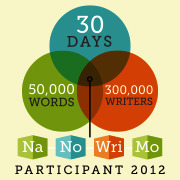 I am a NaNoWriMo novice. I found out about it two years ago, but was too nervous to enter. I thought everyone knew what it was, until so many of my online and writer friends kept asking me why I was now secluded in a mysterious project with a funny name.
I am a NaNoWriMo novice. I found out about it two years ago, but was too nervous to enter. I thought everyone knew what it was, until so many of my online and writer friends kept asking me why I was now secluded in a mysterious project with a funny name.To quote the website: “National Novel Writing Month is a fun, seat-of-your-pants approach to novel writing. Participants begin writing on November 1. The goal is to write a 50,000-word (approximately 175-page) novel by 11:59:59 PM on November 30.”
Sounds easy? Wait, there’s more!
More from the website: “The very first NaNoWriMo took place in July, 1999, in the San Francisco Bay Area. That first year there were 21 of us, and our July noveling binge had little to do with any ambitions we might have harbored on the literary front. Nor did it reflect any hopes we had about tapping more fully into our creative selves. No, we wanted to write novels for the same dumb reasons twentysomethings start bands. Because we wanted to make noise. Because we didn’t have anything better to do. And because we thought that, as novelists, we would have an easier time getting dates than we did as non-novelists.”
Novel idea (no pun intended).
By 2012, they had a huge(ish) organisation, zillions of participants worldwide, an office and a website, and masses of publicity. Not bad for a fun gig!
The rules are simple:
• Write a 50,000-word (or longer!) novel, between November 1 and November 30.
• Start from scratch. None of your own previously written prose can be included in your NaNoWriMo draft (though outlines, character sketches, and research are all fine, as are citations from other people’s works).
• Write a novel. We define a novel as a lengthy work of fiction. If you consider the book you’re writing a novel, we consider it a novel too!
• Be the sole author of your novel. Apart from those citations mentioned two bullet-points up.
• Write more than one word repeated 50,000 times.
• Upload your novel for word-count validation to our site between November 25 and November 30.
Helpful tips include:
 Eat lots of chocolate!• Begin procrastinating by reading through all the great advice and funny stories in the forums. Post some stories and questions of your own. Get excited. Get nervous. Try to rope someone else into doing this with you. Eat lots of chocolate and stockpile noveling rewards.
Eat lots of chocolate!• Begin procrastinating by reading through all the great advice and funny stories in the forums. Post some stories and questions of your own. Get excited. Get nervous. Try to rope someone else into doing this with you. Eat lots of chocolate and stockpile noveling rewards. • On November 1, begin writing your novel. Your goal is to write a 50,000-word novel by midnight, local time, on November 30th. You write on your own computer, using whatever software you prefer.
• If you write 50,000 words of fiction by midnight, local time, November 30th, you can upload your novel for official verification, and be added to our hallowed Winner’s Page and receive a handsome winner’s certificate and web badge. We’ll post step-by-step instructions on how to scramble and upload your novel starting in mid-November.
That’s it in a nutshell. So, how am I doing four days over the halfway mark? I have written a grand total of 31 949 words! I have no idea how to capture a screen image, but here it is in figures. The amazing little calendar on the side of your NaNoWriMometer works everything out for you (no more calculators) and at the end of each day’s writing, just log it into the cute convenient boxes.
Your Average Per Day: 1,681
Words Written Today: 0
Target Word Count: 50,000
Target Average Words Per Day: 1,667
Total Words Written: 31,949
Words Remaining: 18,051
Current Day: 19
Days Remaining: 12
At This Rate You Will Finish On: November 29, 2012
Words Per Day To Finish On Time: 1,505
So, I am ahead, just a little bit. I did not do any writing today (see note further down about malevolent fates) so I HAVE to catch up tomorrow to get back onto schedule. I have never written like this before! No more dabbling around tweaking here and there. One is expected to forge on, relentlessly like a juggernaut to complete the final words—THE END— on 30 November.
The organisers give you loads of gadgets, badges, goodies, and help. They also give you regular pep talks, too. Along the lines of:
1) It’s okay to not know what you’re doing. Really. You’ve read a lot of novels, so you’re completely up to the challenge of writing one. If you feel more comfortable outlining your story ahead of time, do it! But it’s also fine to just wing it. Write every day, and a book-worthy story will appear, even if you’re not sure what that story might be right now.
 Nervous writers should plan in advance.2) Do not edit as you go. Editing is for December and beyond. Think of November as an experiment in pure output. Even if it’s hard at first, leave ugly prose and poorly written passages on the page to be cleaned up later. Your inner editor will be very grumpy about this, but your inner editor is a nitpicky jerk who foolishly believes that it is possible to write a brilliant first draft if you write it slowly enough. It isn’t. Every book you’ve ever loved started out as a beautifully flawed first draft. In November, embrace imperfection and see where it takes you.
Nervous writers should plan in advance.2) Do not edit as you go. Editing is for December and beyond. Think of November as an experiment in pure output. Even if it’s hard at first, leave ugly prose and poorly written passages on the page to be cleaned up later. Your inner editor will be very grumpy about this, but your inner editor is a nitpicky jerk who foolishly believes that it is possible to write a brilliant first draft if you write it slowly enough. It isn’t. Every book you’ve ever loved started out as a beautifully flawed first draft. In November, embrace imperfection and see where it takes you. 3) Tell everyone you know that you’re writing a novel in November. This will pay big dividends in Week Two, when the only thing keeping you from quitting is the fear of looking pathetic in front of all the people who’ve had to hear about your novel for the past month. Seriously. Email them now about your awesome new book. The looming specter of personal humiliation is a very reliable muse.
3.5) There will be times you’ll want to quit during November. This is okay. Everyone who wins NaNoWriMo wanted to quit at some point in November. Stick it out. See it through. Week Two can be hard. Week Three is much better. Week Four will make you want to yodel.
And we’re talking the good kind of yodeling here.
Pep talkers include Neil Gaiman (Coraline), Meg Cabot (Princess Diaries), Sue Grafton (Alphabet murder series), Erin Morgenstern (The Night Circus), Audrey Niffenegger (The Time Traveler’s Wife), Philip Pullman (His Dark Materials), Lemoney Snickett (A Series of Unfortunate Events), and loads of other awfully clever and famous people.
Audrey says: “National Novel Writing Month was a chance to jolt your story onto the page, to use the magic of a deadline to whap out your novel. Now that it is December, I hope you will kick back, have a cup of coffee, reread your 50,000 words, ponder a bit, and then… go for a walk. And on that walk I hope your novel will unclench itself in your brain and let you begin the long, slow, delightful work of rewriting it.”
I started with a great, big, whopping over 4000 words on day one. Wow, I thought, I’ll be finished by next week. Alas, it doesn’t work like that. Somewhere along the line, all sorts of malevolent fates conspire against you, the writer. All sorts of domestic problems or necessities, like shopping, (What happened to the food I bought last week? You ate it?? Why????) just intervene in a most annoying way. In the past, I would have carried on, and not sought to make up the word count I had missed. Aha! Suddenly I had to catch up what I had neglected.
No mistake about it—NaNoWriMo makes you work. I’m loving it!
Published on November 19, 2012 07:32



